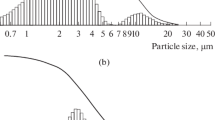Abstract
The effect of transition element additives molybdenum, rhenium, iridium, and osmium on the effective work function of tungsten has been the focus of thermionics research for several years.[1- 5] In this study, iridium-added tungsten powder mixtures were cold compacted and sintered to produce a range of tungsteniridium electrodes. An electron emission study was subsequently carried out to evaluate the work function behavior of the consolidated alloys. The work function was obtained from measurements of the current emitted from the electrode surface under ultrahigh vacuum conditions in the temperature range of 1800 to 2500 K using a vacuum emission vehicle (VEV). The data show that the magnitude of the work function in these alloys varied with temperature. Microstructural evaluation of the alloys indicated that the tested surfaces displayed accentuated thermal etching of the grain boundaries together with the fact that the final grain sizes in the sintered alloys were three to five times smaller than those found in equivalent are-melted alloys that were studied in earlier work.[4,5] Scanning electron microscopy (SEM) micrographs of the tested surfaces of the sintered alloys containing the highest iridium levels (~2 wt % ) show a high level of structural distortion, particularly in the vicinity of grain boundaries and corners. The extent of these distortions was found to vary with the iridium content, i.e., the W-IR3M and W-IR2M. The samples with compositions lower than 0.5 wt % Ir were virtually devoid of distortions. It is proposed that, during homogenization carried out prior to testing, a net accumulation of iridium occurs near the surface, particularly in the vicinity of structural heterogeneities. Subsequent cooling leads to the precipitation of iridium-rich second phase sources, which when reheated to the testing temperatures supplies iridium to a surface monolayer. This mechanism is capable of explaining the observed work function trends during high- temperature testing.
Similar content being viewed by others
References
D.L. Jacobson,Metall. Trans., Vol 3, 1972, p 1263
M.L. Ramalingam, S. Snir, and D.L. Jacobson,J. Mater. Eng., Vol 9, 1988, p 353
N.O. Moraga, Ph.D dissertation, Arizona State University, 1988
R. Wall and D.L. Jacobson,High-Temp. Sci., Vol 30, 1991, p 95
L.A. D’Cruz, D.R. Bosch, and D.L. Jacobson,High-Temp. Sci., to be published
L.A. D’Cruz, Ph.D dissertation, Arizona State University, 1991
E.P. Gyftopoulos and J.D. Levine,J. Appl. Phys., Vol 33, 1962, p 67
D.L. Jacobson and A.E. Campbell,Metall. Trans., Vol 2, 1971, p 3063
R.N. Wall and D.L. Jacobson,J. Mater. Eng., Vol 11, 1989, p 197
J.J. Burton and E.S. Machlin,Phys. Rev. Lett., Vol 37, 1976,p 1433
A. Luo, K.S. Shin, and D.L. Jacobson,Scri. Metall. Mater., Vol 25, 1991, p 2411
Binary Alloy Phase Diagrams, T.B. Massalski, Ed., ASM International, 1990, p 2368
The Oxide Handbook, G.V. Samsonov, Ed., IFI/Plenum, New York, 1982 (translated from Russian)
L.A. D’Cruz, D.R. Bosch, and D.L. Jacobson,J. Refract. Met. Hard Mater., to be published
Author information
Authors and Affiliations
Rights and permissions
About this article
Cite this article
D’Cruz, L.A., Bosch, D.R. & Jacobson, D.L. The high-temperature work function of sintered dilute solution tungsten-lridium alloys. JMEP 2, 81–88 (1993). https://doi.org/10.1007/BF02649678
Issue Date:
DOI: https://doi.org/10.1007/BF02649678




